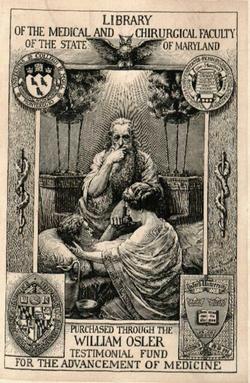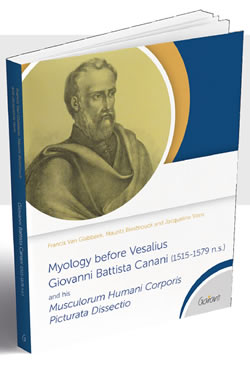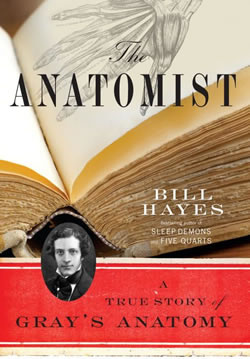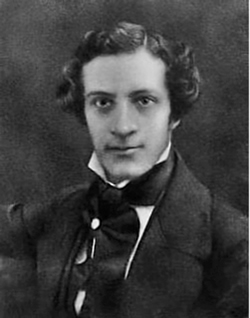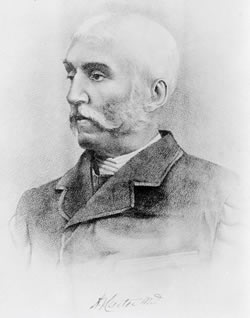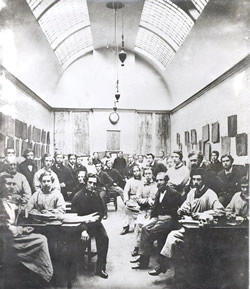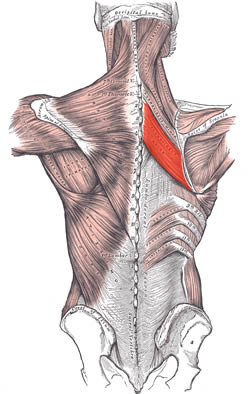
Medical Terminology Daily (MTD) is a blog sponsored by Clinical Anatomy Associates, Inc. as a service to the medical community. We post anatomical, medical or surgical terms, their meaning and usage, as well as biographical notes on anatomists, surgeons, and researchers through the ages. Be warned that some of the images used depict human anatomical specimens.
You are welcome to submit questions and suggestions using our "Contact Us" form. The information on this blog follows the terms on our "Privacy and Security Statement" and cannot be construed as medical guidance or instructions for treatment.
We have 440 guests online
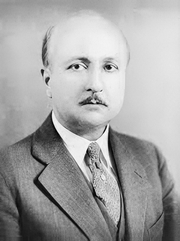
Jean George Bachmann
(1877 – 1959)
French physician–physiologist whose experimental work in the early twentieth century provided the first clear functional description of a preferential interatrial conduction pathway. This structure, eponymically named “Bachmann’s bundle”, plays a central role in normal atrial activation and in the pathophysiology of interatrial block and atrial arrhythmias.
As a young man, Bachmann served as a merchant sailor, crossing the Atlantic multiple times. He emigrated to the United States in 1902 and earned his medical degree at the top of his class from Jefferson Medical College in Philadelphia in 1907. He stayed at this Medical College as a demonstrator and physiologist. In 1910, he joined Emory University in Atlanta. Between 1917 -1918 he served as a medical officer in the US Army. He retired from Emory in 1947 and continued his private medical practice until his death in 1959.
On the personal side, Bachmann was a man of many talents: a polyglot, he was fluent in German, French, Spanish and English. He was a chef in his own right and occasionally worked as a chef in international hotels. In fact, he paid his tuition at Jefferson Medical College, working both as a chef and as a language tutor.
The intrinsic cardiac conduction system was a major focus of cardiovascular research in the late nineteenth and early twentieth centuries. The atrioventricular (AV) node was discovered and described by Sunao Tawara and Karl Albert Aschoff in 1906, and the sinoatrial node by Arthur Keith and Martin Flack in 1907.
While the connections that distribute the electrical impulse from the AV node to the ventricles were known through the works of Wilhelm His Jr, in 1893 and Jan Evangelista Purkinje in 1839, the mechanism by which electrical impulses spread between the atria remained uncertain.
In 1916 Bachmann published a paper titled “The Inter-Auricular Time Interval” in the American Journal of Physiology. Bachmann measured activation times between the right and left atria and demonstrated that interruption of a distinct anterior interatrial muscular band resulted in delayed left atrial activation. He concluded that this band constituted the principal route for rapid interatrial conduction.
Subsequent anatomical and electrophysiological studies confirmed the importance of the structure described by Bachmann, which came to bear his name. Bachmann’s bundle is now recognized as a key determinant of atrial activation patterns, and its dysfunction is associated with interatrial block, atrial fibrillation, and abnormal P-wave morphology. His work remains foundational in both basic cardiac anatomy and clinical electrophysiology.
Sources and references
1. Bachmann G. “The inter-auricular time interval”. Am J Physiol. 1916;41:309–320.
2. Hurst JW. “Profiles in Cardiology: Jean George Bachmann (1877–1959)”. Clin Cardiol. 1987;10:185–187.
3. Lemery R, Guiraudon G, Veinot JP. “Anatomic description of Bachmann’s bundle and its relation to the atrial septum”. Am J Cardiol. 2003;91:148–152.
4. "Remembering the canonical discoverers of the core components of the mammalian cardiac conduction system: Keith and Flack, Aschoff and Tawara, His, and Purkinje" Icilio Cavero and Henry Holzgrefe Advances in Physiology Education 2022 46:4, 549-579.
5. Knol WG, de Vos CB, Crijns HJGM, et al. “The Bachmann bundle and interatrial conduction” Heart Rhythm. 2019;16:127–133.
6. “Iatrogenic biatrial flutter. The role of the Bachmann’s bundle” Constán E.; García F., Linde, A.. Complejo Hospitalario de Jaén, Jaén. Spain
7. Keith A, Flack M. The form and nature of the muscular connections between the primary divisions of the vertebrate heart. J Anat Physiol 41: 172–189, 1907.
"Clinical Anatomy Associates, Inc., and the contributors of "Medical Terminology Daily" wish to thank all individuals who donate their bodies and tissues for the advancement of education and research”.
Click here for more information
- Details
- Written by: Efrain A. Miranda, Ph.D.
This article is part of the series "A Moment in History" where we honor those who have contributed to the growth of medical knowledge in the areas of anatomy, medicine, surgery, and medical research.
For centuries, book owners and collectors have used bookplates to identify their books and their collections, a tradition that seems to be falling in disuse. Not me, I have one that you can see here.
Bookplates (also known as Ex-Libris) can be a tantalizing study, and finding an interesting one is part of what makes an old book a journey of discovery. Every detail in an old book is important. Who owned it? What is their story? Did they leave personal notes within the pages of the books? I have found prescriptions, personal notes, medical shopping lists, and in some cases corrections to the book itself! One of the most interesting cases of this is Vesalius' Annotated Fabrica!
Bookplates are very personal. In many cases, they depict the coat of arms of the owner’s family, sometimes a motto that drove the book’s owner, the book owner's hobbies, and in some cases a humorous jab at something.
While researching my series of articles on Dr. Ephraim McDowell, I ordered the book “EPHRAIM MCDOWELL, FATHER OF OVARIOTOMY AND FOUNDER OF ABDOMINAL SURGERY. With an Appendix on JANE TODD CRAWFORD”. By AUGUST SCHACHNER, M.D. Cloth, 8vo.A p. 33I. Philadelphia, J. B. Lippincott CO., I921. A great book, I finished reading it overnight!. Dr. McDowell has also been featured in this blog in the series "A Moment in History"
What interested me was the bookplate on the book frontis, a picture of which I placed in this article. It is from the Library of the Medical and Chirurgical faculty of the State of Maryland, and has a legend that states "Purchased through the William Osler Testimonial fund for the advancement of Medicine”. It depicts a physician (probably Hippocrates) taking the pulse of a patient.
Further research indicated that this bookplate was created to honor Sir William Osler by the Maryland State Medical Society and that Dr. Osler’s books never had personal bookplates. MedChi (Maryland State Medical Society) commissioned this plate that depicts the four seals of the universities with which Osler was affiliated: McGill in Montreal, University of Pennsylvania in Philadelphia, Johns Hopkins in Baltimore and Oxford in England. The images are flanked by two rods of Asclepius.This Ex-Libris was designed and drawn by Max Brödel (1870 – 1941) a famous medical illustrator who worked at the Johns Hopkins School of Medicine in Baltimore and illustrated for Harvey Cushing, William Halsted, Howard Kelly, and other notable clinicians. Brödel was a personal friend of Osler. The bookplate was such a hit that doctors from all over the country requested copies of it, which the librarian at the time Ms. Marcia Crocker Noyes, sent but with the request of receiving the requestor’s own bookplate. You can see all of them in the attached links in the "Sources" section. Interestingly, Ms. Marcia Crocker Noyes has been suspected of still haunting the library where she worked!!
An old book is important not only because of its content, but also because of its provenance. You know where you are going to start reading it, but you never know where are you going to end in researching it. Should you want to have your own bookplate, you can order them from BookPlateInk. On a personal note, develop your own bookplate. It's your legacy. If you want to see my Ex-Libris, it is in my library catalog page. Dr. Miranda.
Sources:
1. Ex Libris: The Bookplate Collection, Part I MedChi
2. Happy Birthday, Sir William! MedChi
3. The bookplate that never was McGill University (PDF)
4. The Osler Library of the History of Medicine: McGill's Medical Memory. Lyons C Mcgill J Med. 2011 Jun; 13(1): 90.
5. The MedChi Collection of Bookplates
6. Max Brödel & MedChi
- Details
UPDATED: This article was originally titled "[friggatriskaidekaphobia], a word that means "fear of Friday the thirteenth".
It is based on the term [triskaidekaphobia] which means "fear of the number thirteen". Although in modern Greek the number thirteen is pronounced [dekatria] (δεκατρία), the term triskaideka means "three and ten" in older Greek. Add the Greek suffix [φοβία] [phobia] meaning "fear" and you have the word triskaidekaphobia. An alternate spelling is triskadekaphobia
The term [Frigga] refers to a Norse goddess after whom the name for the day Friday originates. Frigga is the wife of Odin and the mother (or stepmother, depending on who interprets old traditions) of Thor.
Reading the book "Complications: Notes from the Life of a Young Surgeon" by Atul Awande. MD (one of the books in my library) I came across a synonym for this concept, the word "paraskevidekatriaphobia" also written as "paraskevideikatriaphobia". The author does not explain the origin or etymology of the term. What he does say is that in the United States, on Friday the 13th, people "perform rituals before leaving the house, call in sick to work, or postpone flights or major purchases, causing businesses to lose $750 million annually". Keep in mind that this book was written in 2002. A simple calculation at https://www.inflationtool.com/ shows that by 2022, this corresponds to 1.2 billion dollars!
The origin of the superstition that Friday the 13th is a bad day started on Friday the 13th, 1307. On this date all the Knights Templar were rounded, arrested, accused, tortured, and executed. It is indeed a bad day, but only if you are a member of the Knights Templar!
- Details
- Written by: Efrain A. Miranda, Ph.D.
[UPDATED 11/30/2023] This is a book published recently by my good friends Francis Van Glabbeek, Maurits Biesbrouck, and Jacqueline Vons.
This group is dedicated to the works of Andreas Vesalius and his influence on Medicine, Surgery and the Arts. As part of the analysis of Vesalius’ works they started research on a far less-known anatomist, Giovanni Battista Canani (1515 - c.1579). Cananis’ last name is sometimes presented as Canano.
The authors researched a book of which there are only 15 known copies in the world, far less than Vesalius’ Fabrica, "Musculorum Humani Corporis Picturata Dissectio". Of these 15 copies, only two are in the USA, one at Yale University, the other at Duke University. The online version of the Duke University can be seen or downloaded here.
Canani was born in Ferrara, Italy and was a remarkable and leading physician-anatomist in the sixteenth century, but he is far less well known today than contemporaries such as Vesalius, Fallopio or Colombo.His only work on the muscular anatomy of the upper limb Musculorum Humani Corporis Picturata Dissectio (Dissection Images of the Muscles of the Human Body) can in fact be considered as a masterpiece of its time, no less innovative than Vesalius’ Fabrica. The book is revolutionary in its content and contains copper etchings of exceptional quality and precision. This is the result of Canani’s extensive dissections of human corpses, performed meticulously and with a determination to discover the tiniest details of the human anatomy.
In fact, Canani came from a distinguished medical family and developed into an anatomist at an early age. He was trained by Marcantonio della Torre, an associate of Leonardo da Vinci, and was Pope Julius IIIs personal physician until his death in 1555, after which he became chief physician at the University of Ferrara. He discovered the palmaris brevis muscle in the hand and was the first to describe the valves in the veins, a fact which he communicated to his contemporary, Vesalius. Around 1542, he published a small volume of twenty leaves on the muscles of the arm and forearm. This was to be the initial book of may be a larger work he planned to produce; however, it was the only book that was completed. It is thought that he felt his work was so overshadowed by Vesalius' Fabrica that he destroyed as many copies as he could recover. This would explain the scarcity of copies of Canani’s original book.
Thankfully, the book by Van Glabbeek, Maurits Biesbrouck and Jacqueline Vons contains a color facsimile of Cananis’ publication and should be a fantastic addition for any student of Medical History or collector of Vesaliana. You can order your copy by clicking here or use the QR code in this article.
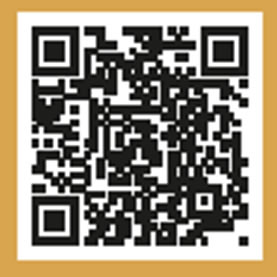
Professor Francis Van Glabbeek, anatomist and surgeon, founding member and member of BIOMAB (Biological and Medical Art in Belgium), is a passionate collector of antiquarian medical books, has been a driving force in continuing Vesalius’s legacy by bringing artists together with scientists, and, in the spirit of Vesalius, teaching anatomy from direct observation.
Maurits Biesbrouck is a well known Vesalius scholar who published a Dutch translation of the first volume of the 1543 Fabrica by Vesalius, as well as a Vesalius bibliography as well as a summary and discussion of the editions of his works.
Jacqueline Vons is Professor Emeritus of classical languages at Université François Rabelais in Tours, France. Together with Prof. Stephane Velut, Professor of Anatomy at the same university, she published the first French translation of Vesalius’s Epitome and is currently working on the French translation of Vesalius’s 1543 Fabrica.
Personal note: In June, 2023 I was invited by the University of Antwerp to present at the 2023 Vesalius Triennial Meeting. I used the opportunity to have Professor Francis Van Glabbeek sign my copy of his book, which is now part of my library. Dr. Miranda.
Sources:
1. “Myology before Vesalius - Giovanni Battista Canani (1515 - 1579 n.s.) and his Musculorum Humani Corporis Picturata Dissectio " Van Glabbeek,F; Biesbrouck, M.; Vons, J. 2022. Garant, Belgium.
2. "Musculorum Humani Corporis Picturata Dissectio" Sigersit, HE. 1925 Lier & Co. Florece, Italy.
- Details
This article is part of the series "A Moment in History" where we honor those who have contributed to the growth of medical knowledge in the areas of anatomy, medicine, surgery, and medical research.
As you know, I am interested in the history of Science, Medicine, and specially, Human Anatomy. Because of that and as part of this website we added a series called "A Moment in History". The objective was to create a series of articles to honor those individuals who have contributed to the growth of medical knowledge in the areas of anatomy, medicine, surgery, and medical research including individuals who have contributed in different ways, but still added their life work to the advancement of medical knowledge.
One of the individuals who piqued my interest was Henry Gray, FRS author of one of the great teaching books on anatomy ever written, “Gray’s Anatomy”. This book was first published in England in 1858, later published in the USA from 1862 to 1990. The English Edition is still published and is now in its 42nd Edition.
I started to look deeper into his life which, I learned with surprise, was not only very short, but obscure. Researching into Henry Gray’s life, I came about this book: “The Anatomist – A True Story of Gray’s Anatomy” by William (Bill) Hayes.
Bill Hayes started looking into Henry Gray’s life with the intent of writing a biography. He rapidly run into a wall. Besides a well-detailed list of academic titles and positions, degrees awarded, and scientific papers that he published. As the author states “what I had gathered about him would amount to little more than a Curriculum Vitae”. So, he starts a journey to uncover more data about Gray’s life and his well-known book.
Part of his journey was to understand the importance of anatomy as a component of the medical curriculum. Bill Hayes was accepted as a participant in the anatomy laboratory for physical therapy students and later visited medical students in the anatomy lab. Just his observations and comments throughout the book on these activities is worth reading this book.
What is interesting is the lack of personal information on Henry Gray. To this date, we do not have information about his birth, either location or date. There is more information on his family that on the subject. Most agree that Henry Gray was born in 1827, but some propose 1825. Either way, there is no firm data. What we do know is that he died on June 12, 1861, having contracted smallpox most probably from his nephew Charles Gray. Henry Gray was 36 years old.
Here is one of the few photographs that exists of Henry Gray. In this particular 1870 picture by Joseph Langhorn, Gray is in the anatomy laboratory (forefront, third from the left) at St. George’s Hospital with his students. At the time it was customary for medical students to pose in the lab with bones and cadavers. This is a practice not in use today and disappeared circa 1930. For anyone interested in this now considered gruesome custom, I would recommend the book "Dissection" by John H. Warner and James M. Edmonson.
In his research, the author discovers Henry Gray’s collaborator and illustrator of the book: Henry Vandyke Carter, MD. Where Gray is obscure and with no personal information, Henry Carter writes a diary daily, and for some time he actually writes another diary that he calls “Reflections” on more personal and religious topics. Carter is a troubled, complicated individual blessed with incredible anatomical knowledge and drawing capabilities that can be seen throughout the book.
It is because of these diaries that we know Henry Carter and we can glimpse (almost at a distance) the character of Henry Gray, but it is not enough to elucidate his biography. In some ways it is like looking at an individual through a veil. You see him, but it is nebulous.
Much of the book is concentrated on Henry Carter, his life, his depression bouts, his self doubts and the work that he did illustrating Gray’s book. In some ways he is behind the scenes, and even though he did much of the dissection work and illustration, Henry Carter is mostly unknown to the anatomical world, as in may cases the medical illustrators are, with some notable exceptions.
Henry Carter is paid only 150 pounds for his work and even before getting paid he pays for a ticket to India where he accomplishes his objectives in life and in academia. Henry Carter eventually retires and comes back to England where he dies in 1897.
Bill Hayes and his partner visited rare book libraries at different universities and eventually go to London to visit areas and locations where Henry Gray lived and worked. There is a sense of accomplishment, but also a sense that we can almost touch the life of Henry Gray but fall short of seeing him.
The book ending is poignant, dealing with personal matters and thoughts on life and death. Eventually the author is very clear that the study of anatomy, although on dead subjects who donated their bodies to the universities is actually an activity that helps us understand life.
Bill Hayes is an awarded author of seven books, a frequent contributor to the New York Times and a photographer. More information about him and his activities at https://www.billhayes.com
Personal note: This is a book that I personally recommend and proud to add to my personal library. My one observation is that the author should have probably name the book “The Anatomists - A True Story of Gray’s Anatomy” as it is the story of the life of the two Henrys: Gray and Carter. In fact, I believe that Gray’s Anatomy could have been called “Gray’s and Carter’s Anatomy”, had history been slightly different – Dr. Miranda.
Sources:
1. “Henry Gray and Henry Vandyke Carter: Creators of a Famous Textbook" Roberts, S. J Med Biog 2000 8: 206-212
2. "Henry Gray, Anatomist: An Appreciation" Boland, F Am J Med Sci 1908 1827-1924
3. "The Anatomist: A True Story of Gray’s Anatomy" Hayes, B. Random House PG 2007
- Details
The rhomboid major muscle is found in the posterior aspect of the thorax between the spine and scapula. This muscle originates from the spinous processes of the thoracic vertebrae T2 to T5 as well as the supraspinous ligament at these levels by way of an aponeurosis that varies in width. It inserts on the medial border of the scapula, from about the level of the scapular spine to the inferior angle of the scapula by way of short tendinous fibers.
It adducts, elevates, and inferiorly rotates the scapula. It also helps to maintain the scapula flush with the posterior aspect of the thoracic cage. It is innervated by the dorsal scapular nerve (C4, C5), a branch of the brachial plexus.
The Terminologia Anatomica name for the muscle is musculus rhomboideus major.
The rhomboid major is one of the 17 muscles that attach to the scapula.
Sources:
1. “Gray’s Anatomy” Henry Gray, 1918
2. "Tratado de Anatomia Humana" Testut et Latarjet 8th Ed. 1931 Salvat Editores, Spain
3. "Gray's Anatomy" 38th British Ed. Churchill Livingstone 1995
4. “An Illustrated Atlas of the Skeletal Muscles” Bowden, B. 4th Ed. Morton Publishing. 2015
5. "Morris' Human Anatomy" Pearce, J. (1942) Blakiston Co. Philadlephia USA
6. "Trail Guide to The Body" 4th. Ed. Biel, A. Books of Discovery. 2010
Image modified from the original by Henry VanDyke Carter, MD. in the book "Grays's Anatomy" by Henry Gray FRS. Public domain
- Details
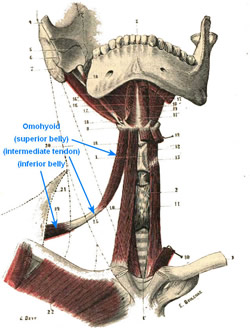
Omohyoid muscle.
Click on the image for a larger depiction
The omohyoid also known as the musculus omohyoideus is the most lateral of the infrahyoid muscles, the others being the sternohyoid, sternothyroid, and thyroid muscles.The omohyoid is a long muscle formed by two muscular bellies (superior and inferior) and an intermediate tendon.
The inferior belly originates from the superior margin of the scapula, near the superior transverse ligament of the scapula. Sometimes, as a variation, the tendon of the inferior belly originates directly from this ligament. The inferior belly passes medially, posteriorly, and slightly superiorly towards the intermediate tendon. The medial aspect of this belly is deep to the trapezius muscle.
The intermediate tendon is held in place by a strong extension of the middle layer of the cervical fascia. This extension has firm attachments to the first rib and the posterior surface of the clavicle.
Along with the other infrahyoid muscles, the omohyoid muscle depresses the hyoid bone. Each belly receives a separate branch that arises from the ansa cervicalis (C1, C2, and C3).
Note: The image in this article was taken from the book "Tratado de Anatomía Humana" by Testut and Latarjet. The illustration was made by George Devy, a famous French painter who specialized in anatomical illustrations (? -1902) and the engraving was made by a Swiss artist, Edmond Boulenaz (1859-1905). This image is in the Public Domain and has been edited by us.
Sources:
1. “Gray’s Anatomy” Henry Gray, 1918
2. "Tratado de Anatomia Humana" Testut et Latarjet 8th Ed. 1931 Salvat Editores, Spain
3. "Gray's Anatomy" 42nd British Ed. Churchill Livingstone 2021
4. “An Illustrated Atlas of the Skeletal Muscles” Bowden, B. 4th Ed. Morton Publishing. 2015
5. "Trail Guide to The Body" 4th. Ed. Biel, A. Books of Discovery. 2010
6. "Petite histoire de l'iconographie anatomique" Huard, P; Imbalt-Huart, MJ Communication présentée à la Société Française d'Histoire de la Médecine, le30 septembre 1972.
7. https://www.anatomicalterms.info


